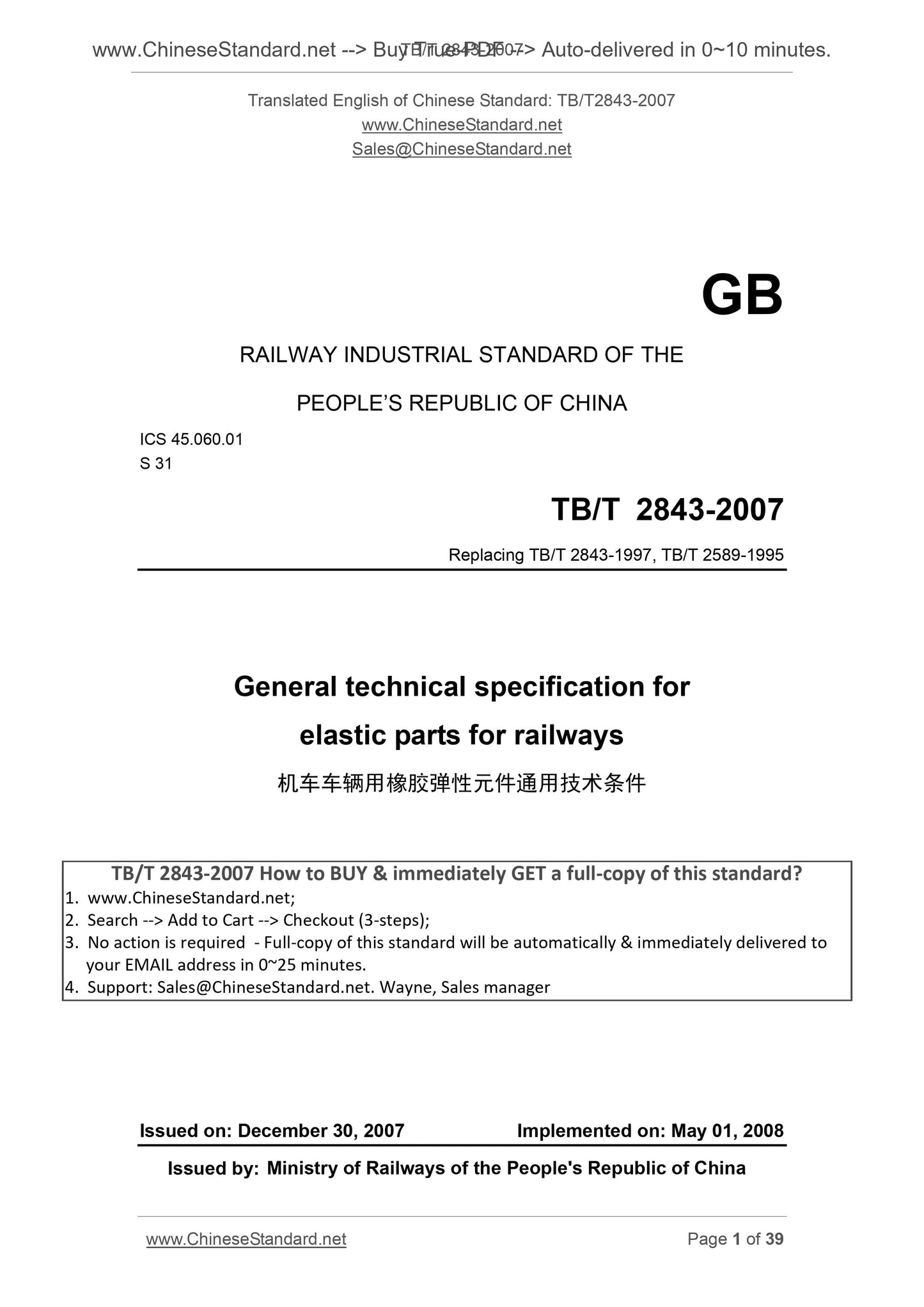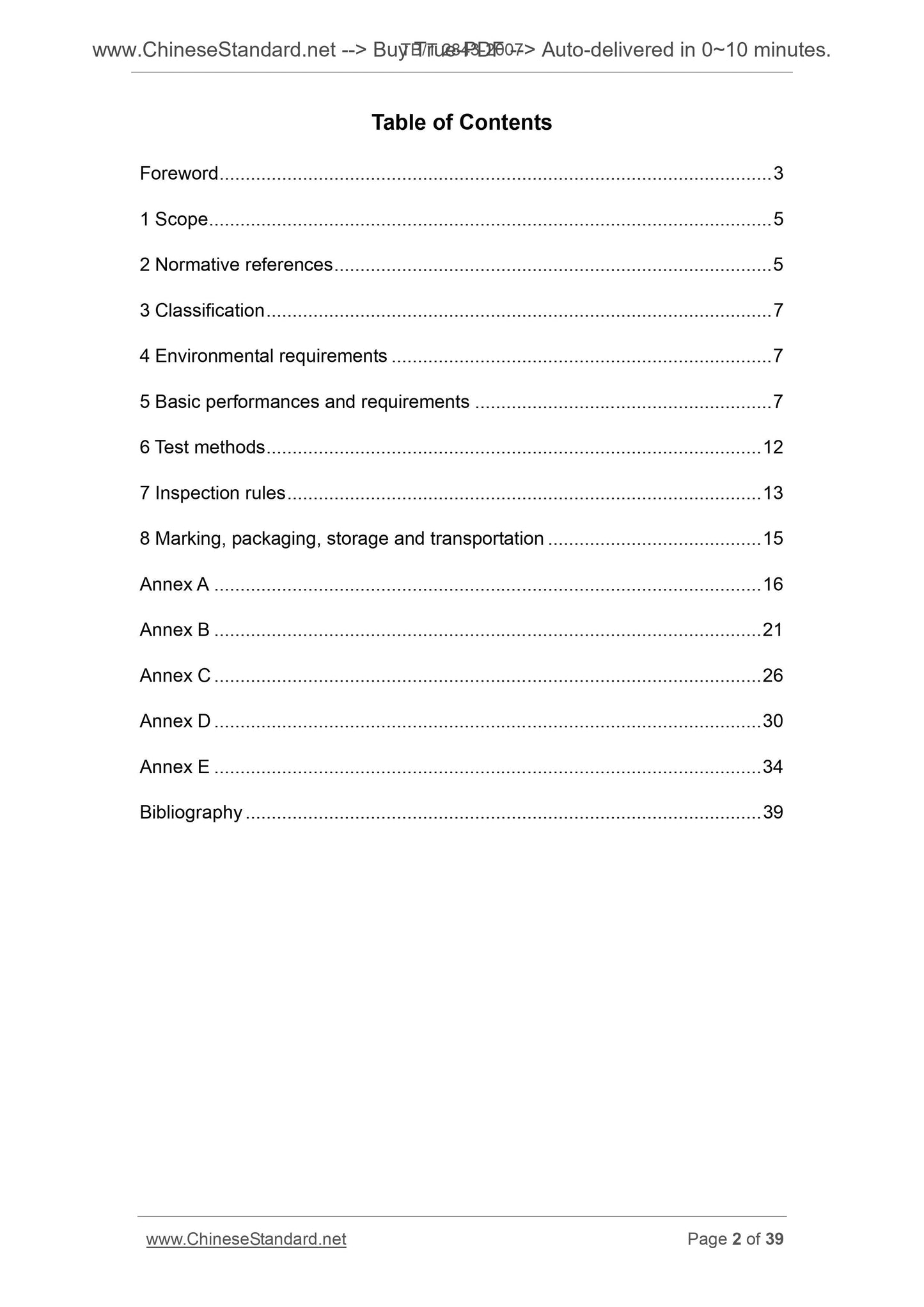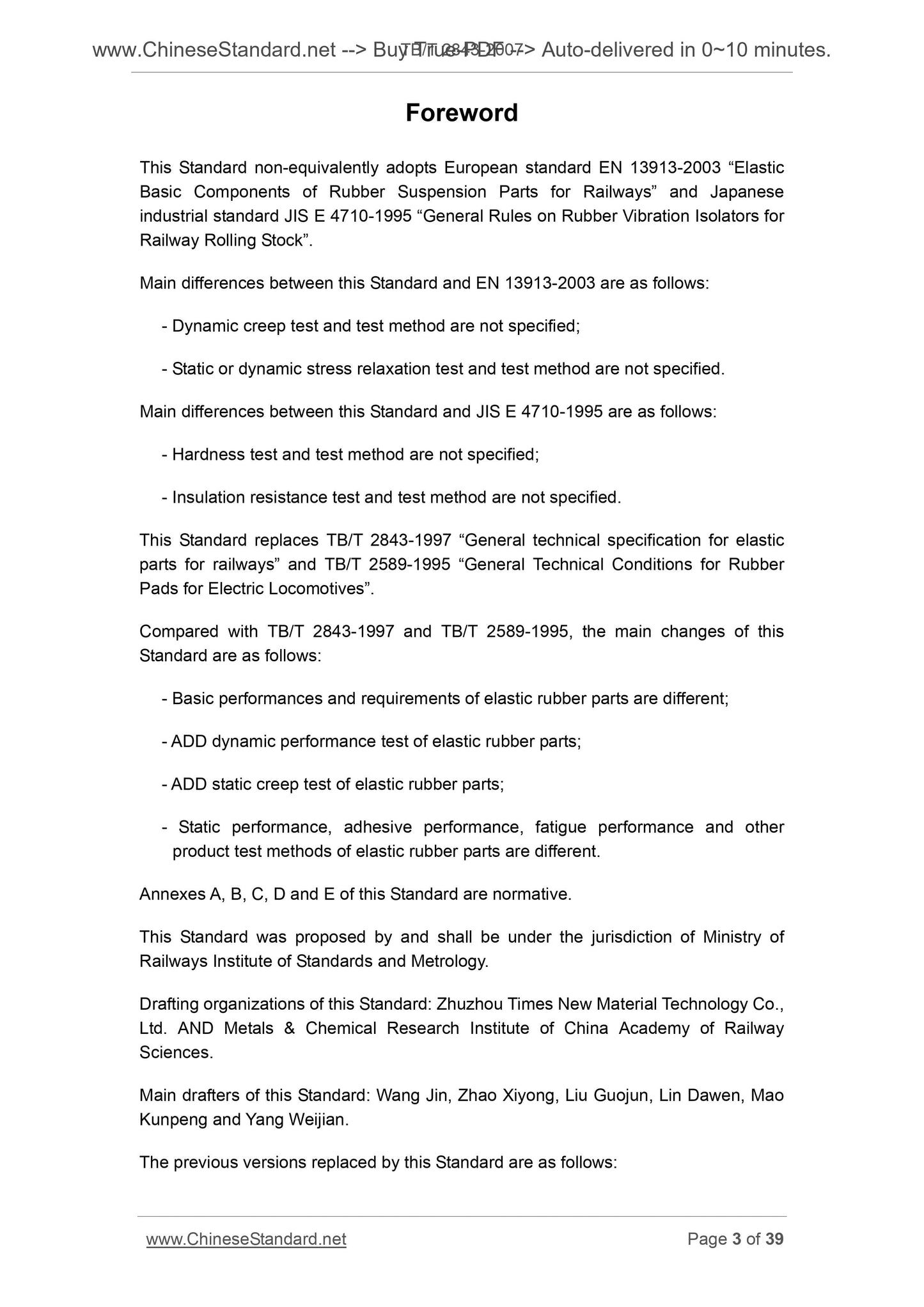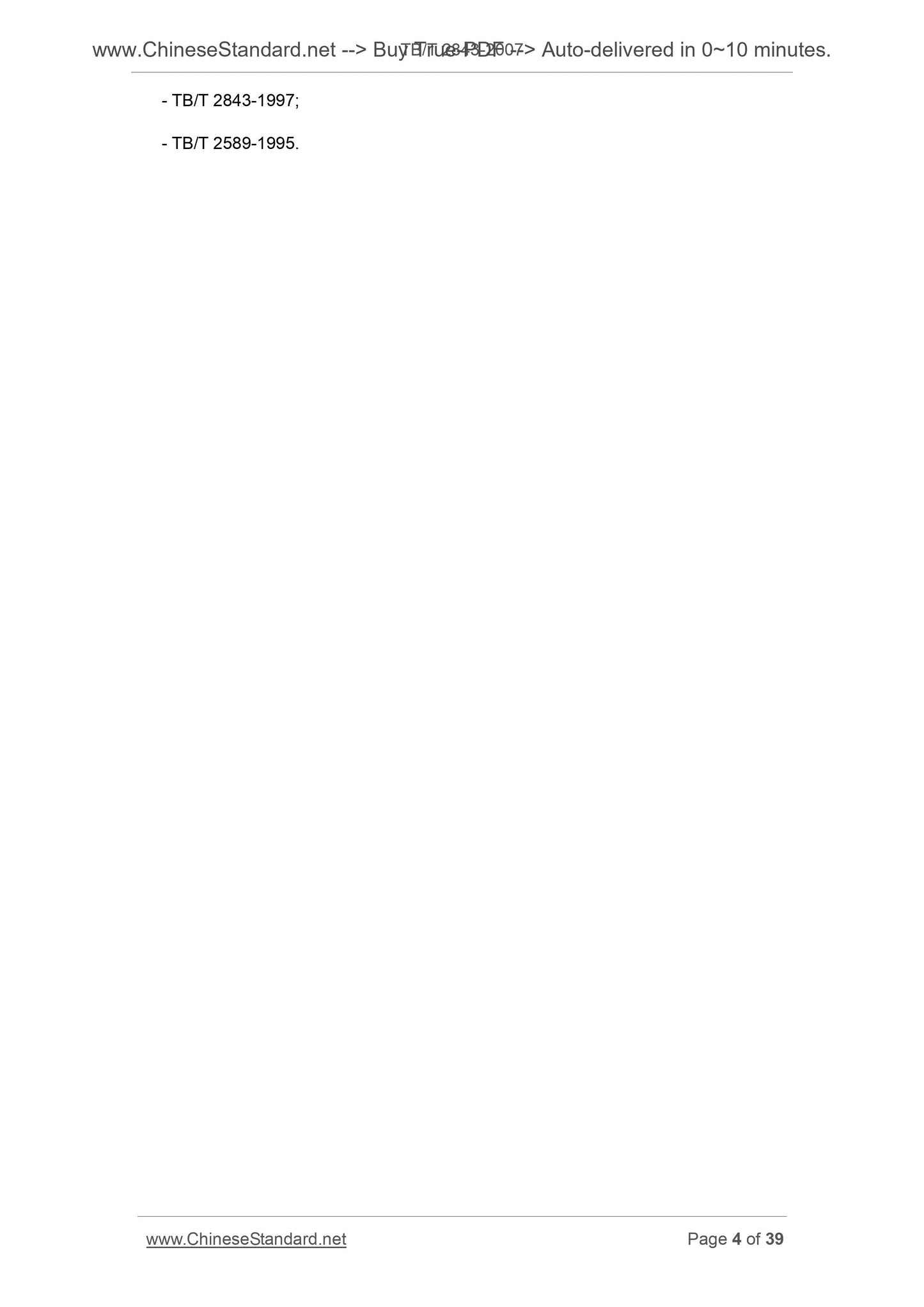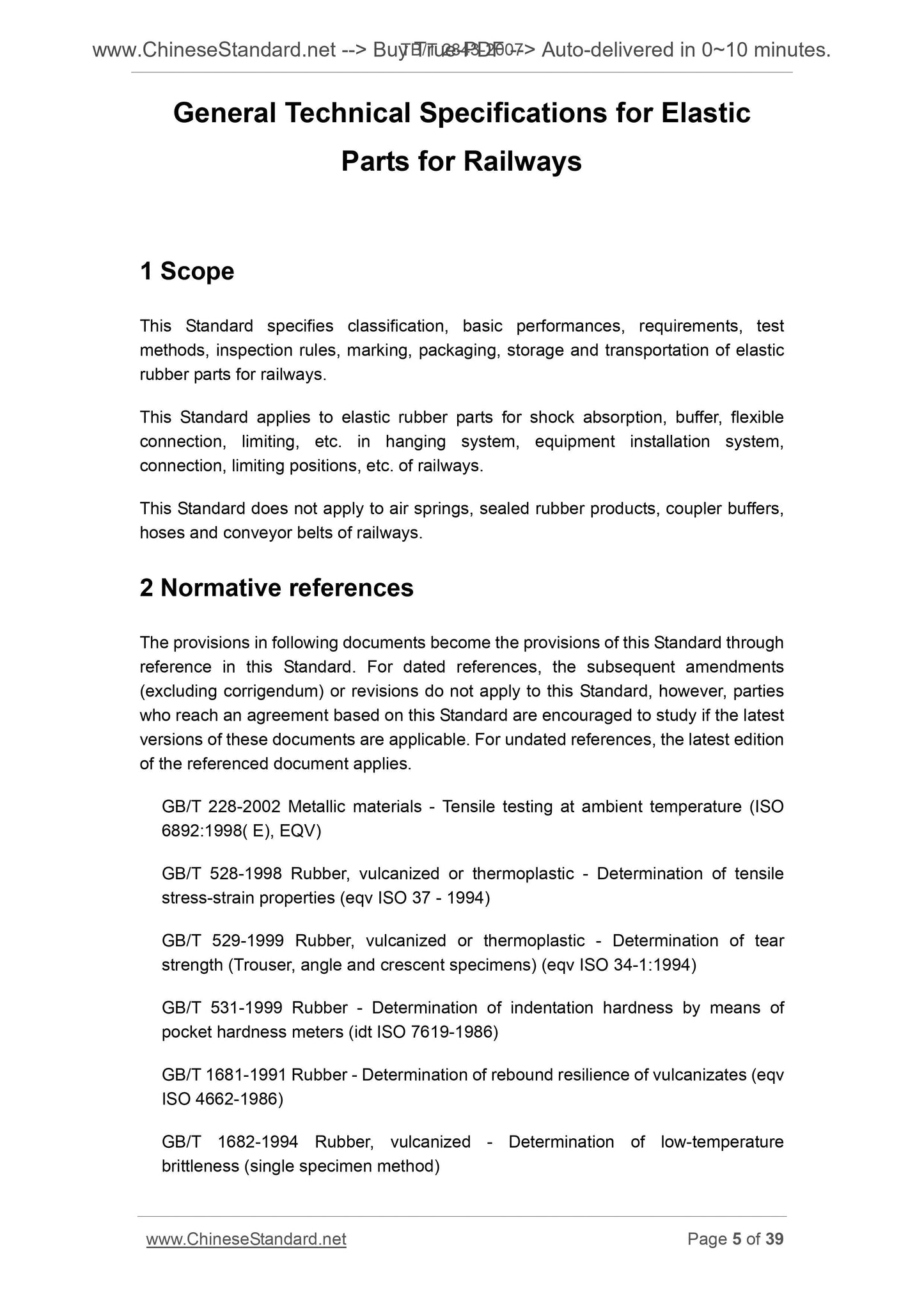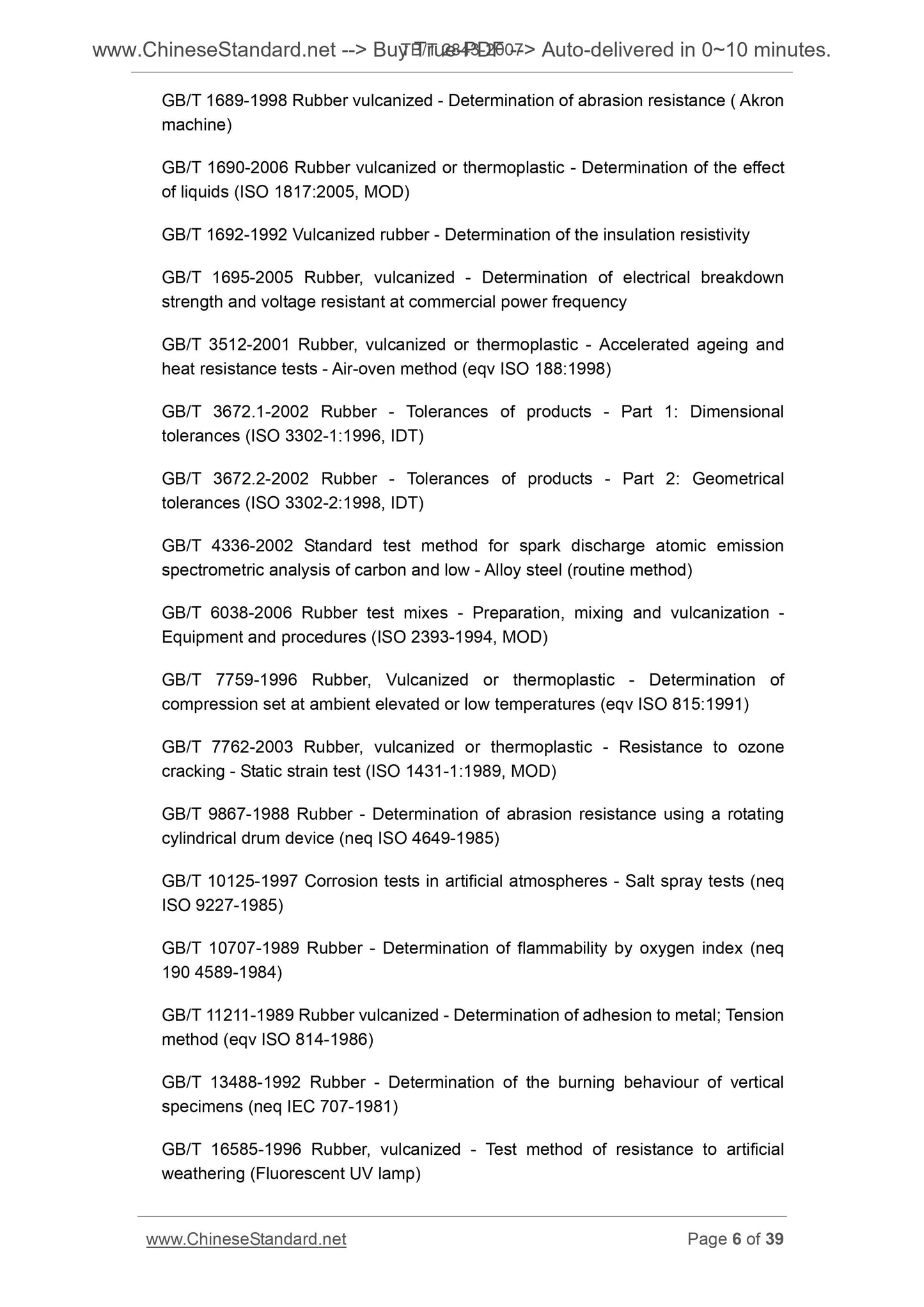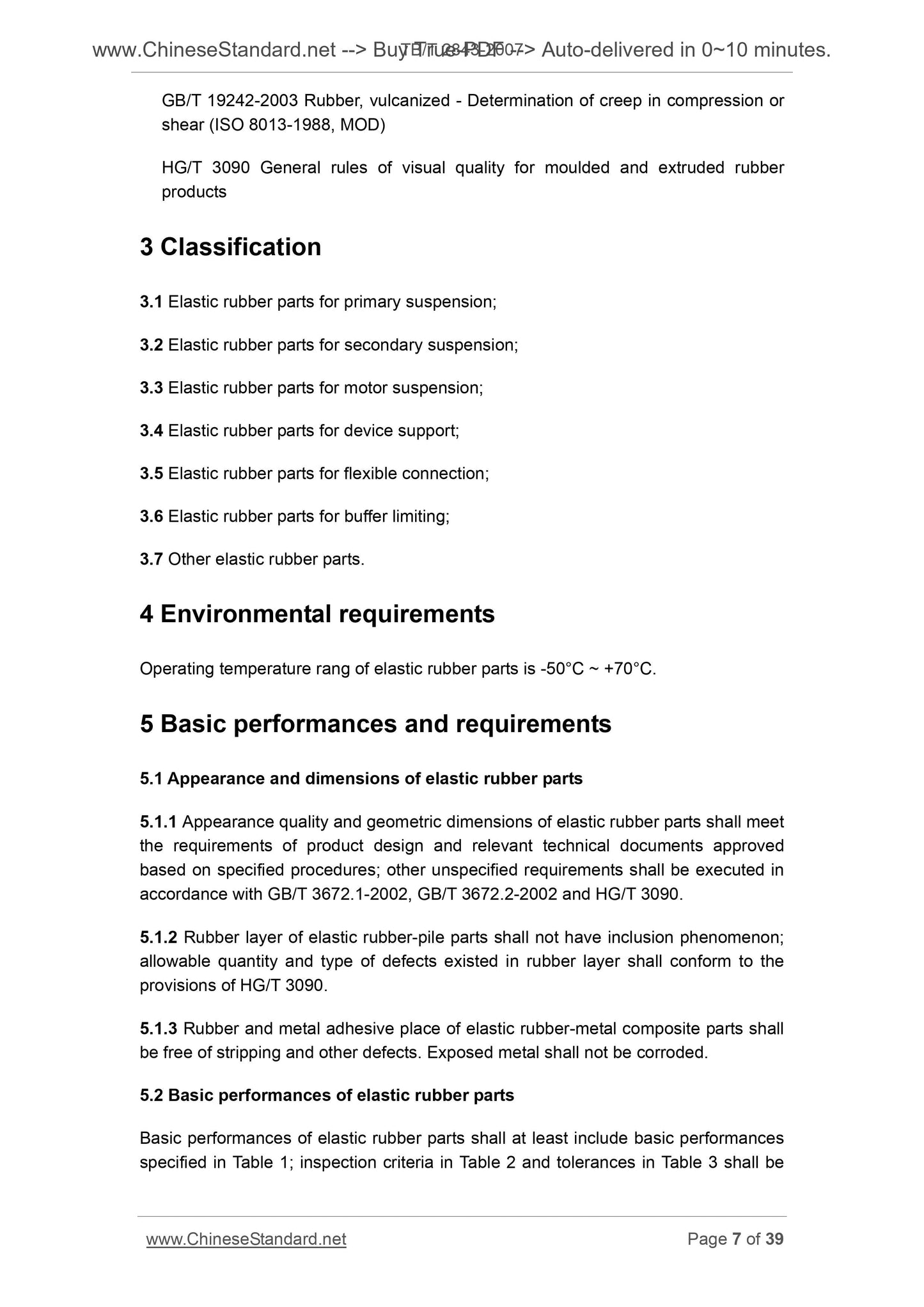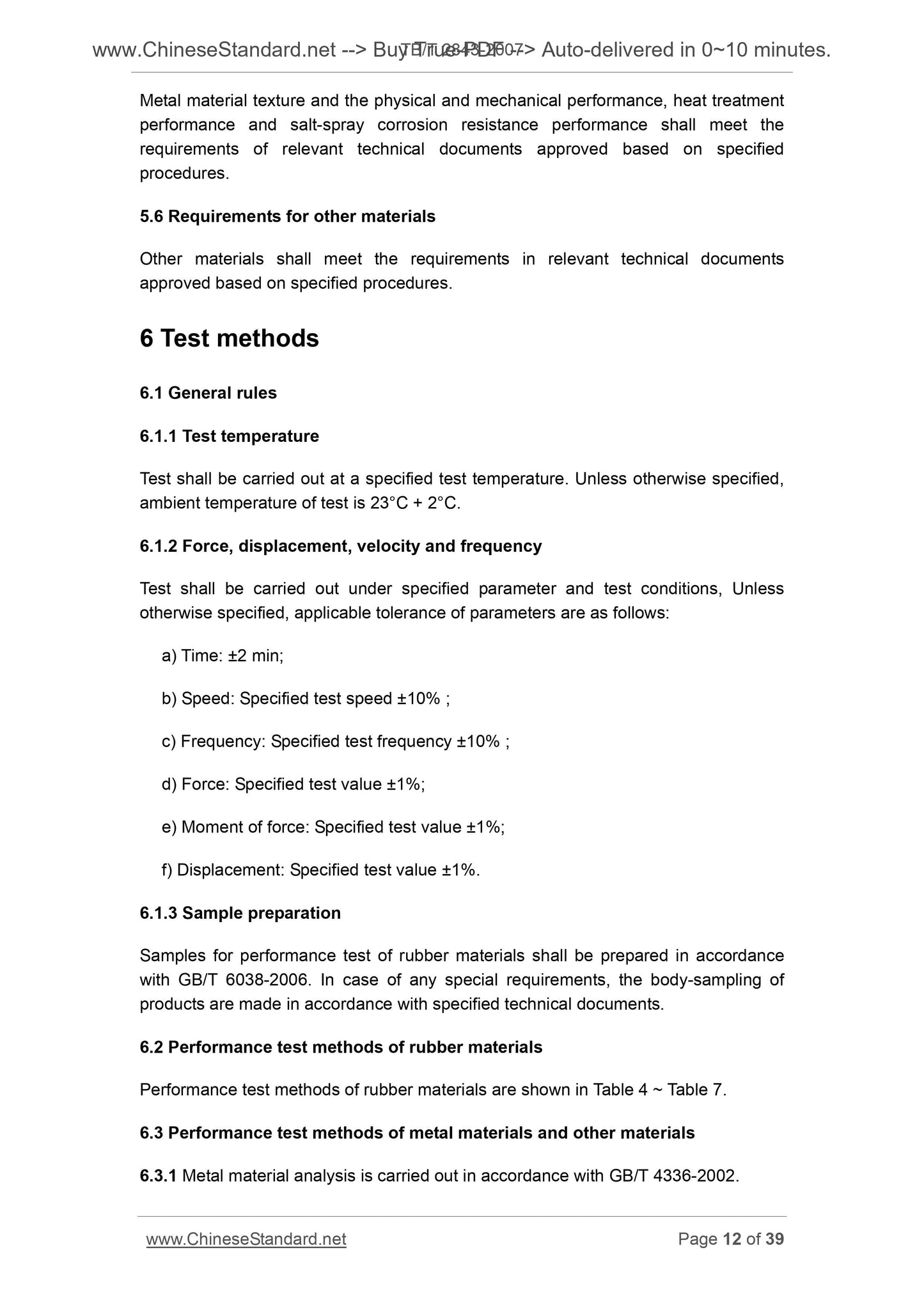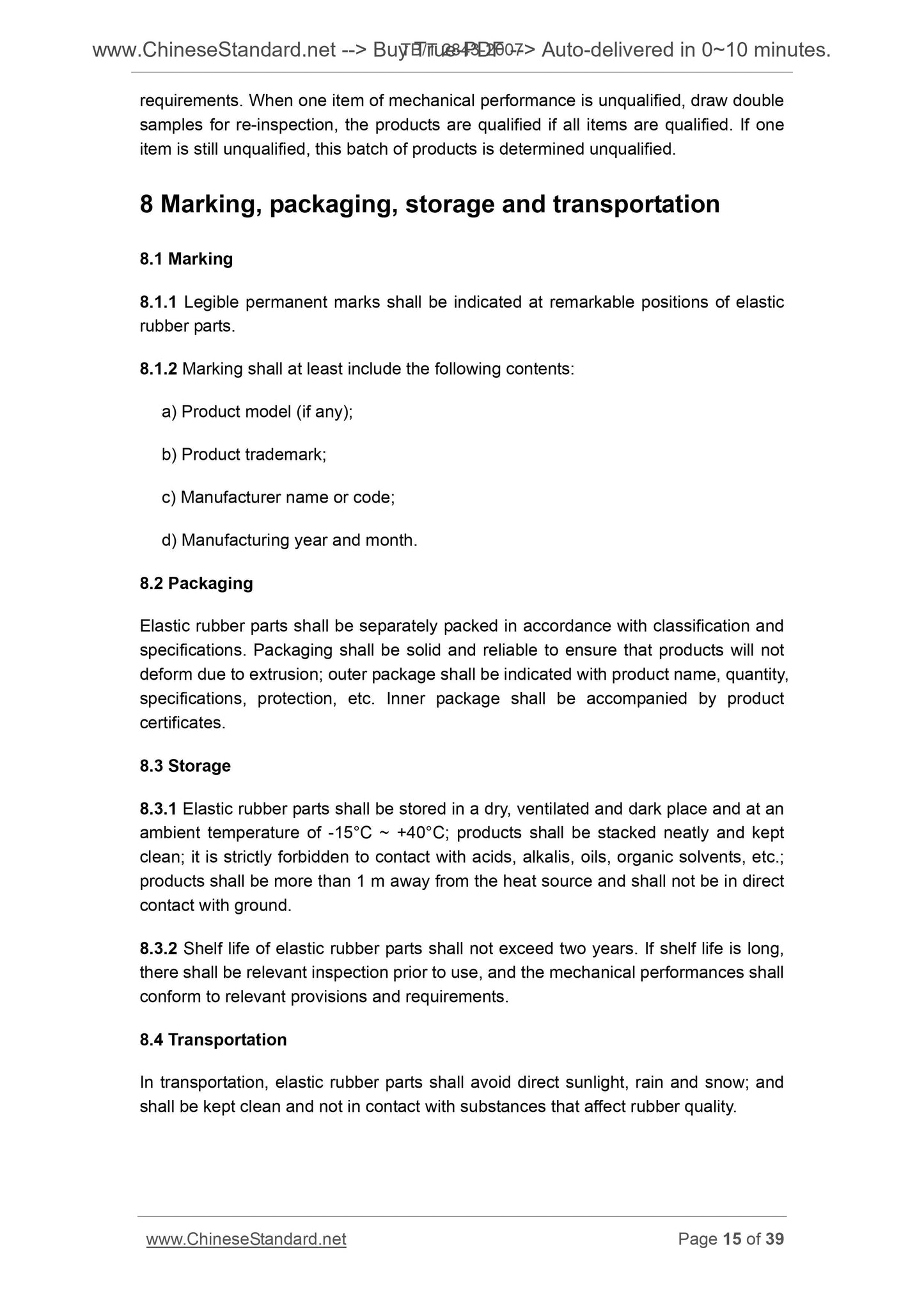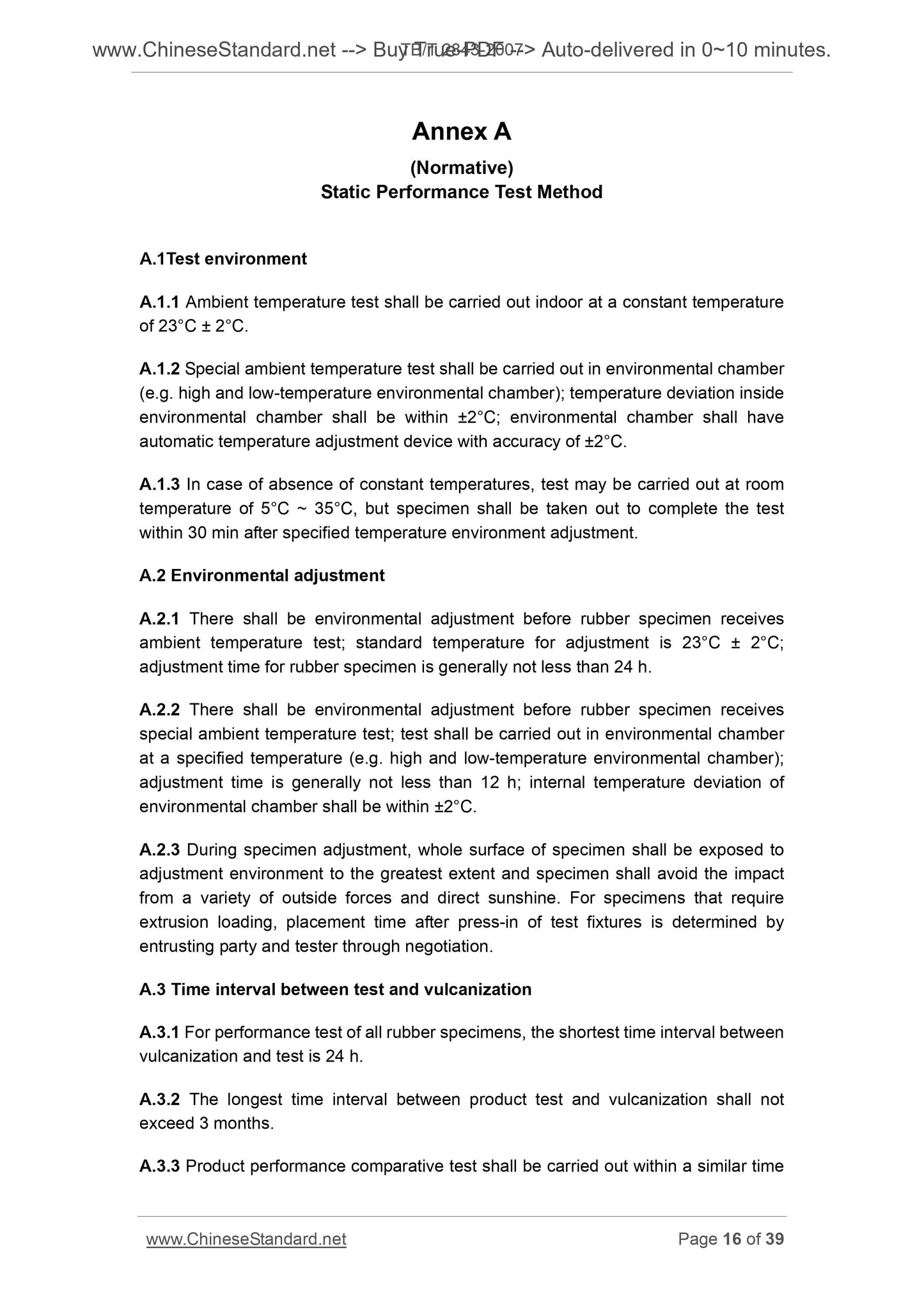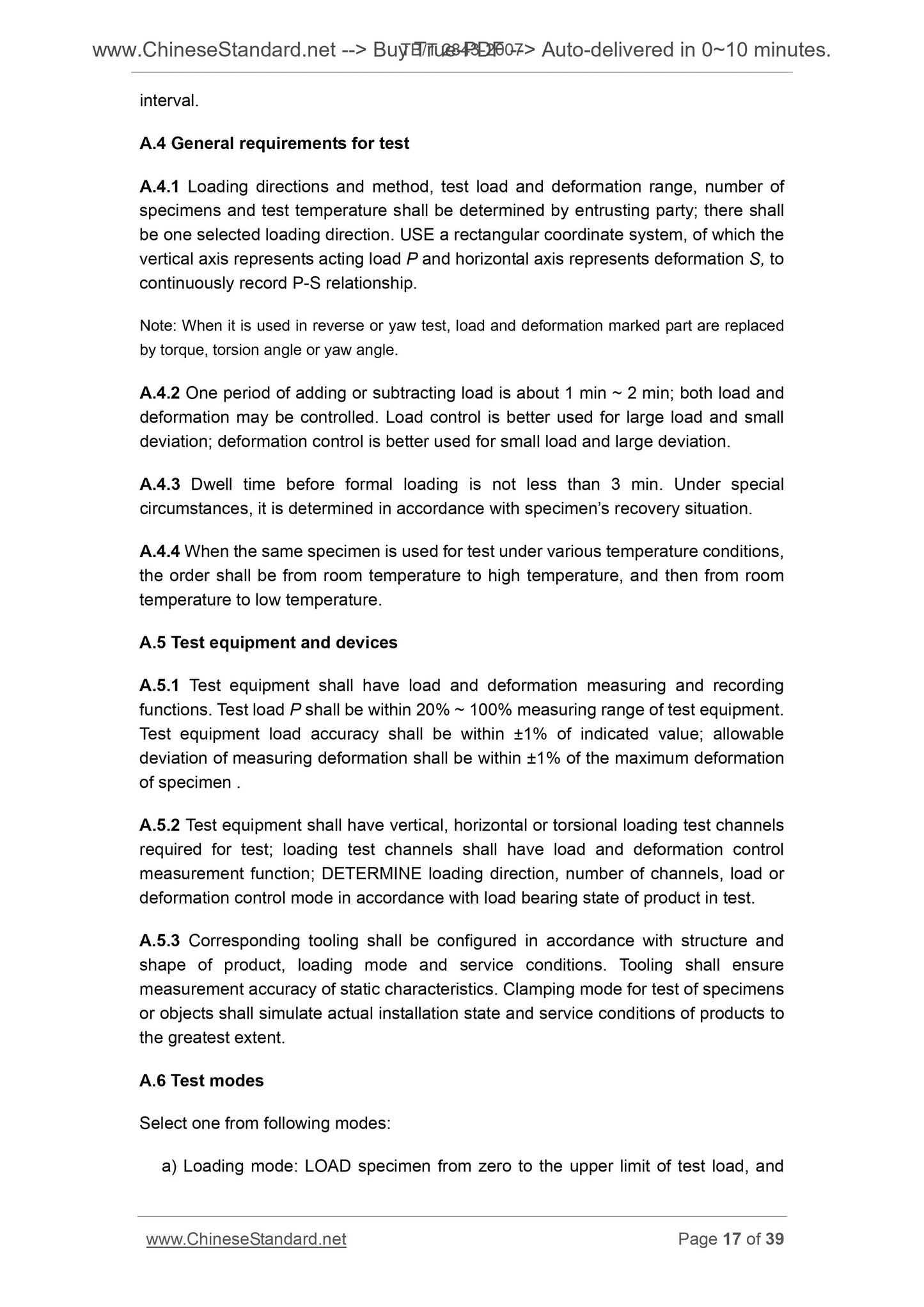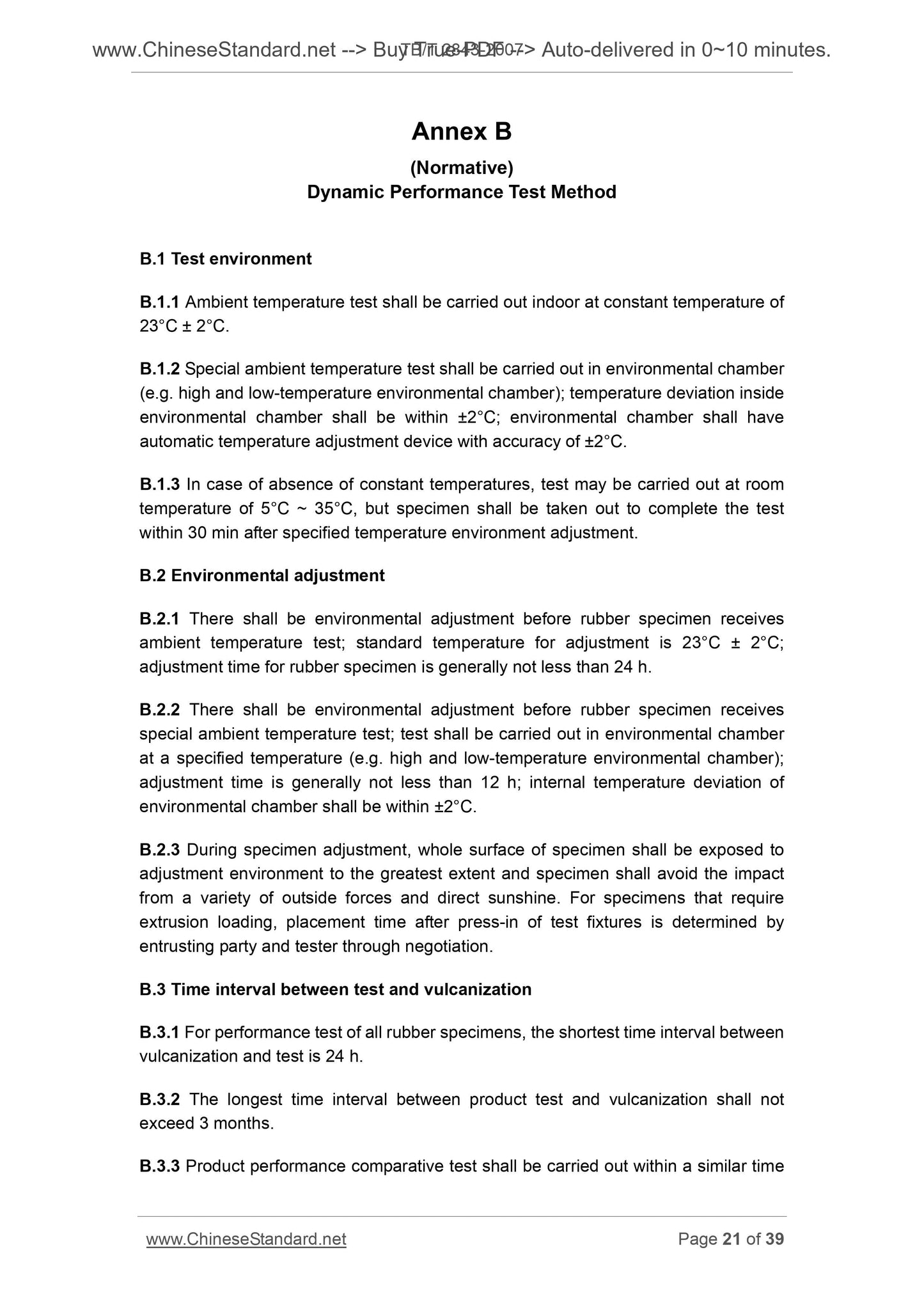PayPal, credit cards. Download editable-PDF and invoice in 1 second!
TB/T 2843-2007 English PDF (TBT2843-2007)
TB/T 2843-2007 English PDF (TBT2843-2007)
Precio habitual
$270.00 USD
Precio habitual
Precio de oferta
$270.00 USD
Precio unitario
/
por
Los gastos de envío se calculan en la pantalla de pago.
No se pudo cargar la disponibilidad de retiro
Delivery: 3 seconds. Download true-PDF + Invoice.
Get QUOTATION in 1-minute: Click TB/T 2843-2007
Historical versions: TB/T 2843-2007
Preview True-PDF (Reload/Scroll if blank)
TB/T 2843-2007: General technical specification for elastic parts for railways
TB/T 2843-2007
GB
RAILWAY INDUSTRIAL STANDARD OF THE
PEOPLE’S REPUBLIC OF CHINA
ICS 45.060.01
S 31
Replacing TB/T 2843-1997, TB/T 2589-1995
General technical specification for
elastic parts for railways
ISSUED ON. DECEMBER 30, 2007
IMPLEMENTED ON. MAY 01, 2008
Issued by. Ministry of Railways of the People's Republic of China
Table of Contents
Foreword ... 3
1 Scope ... 5
2 Normative references ... 5
3 Classification ... 7
4 Environmental requirements ... 7
5 Basic performances and requirements ... 7
6 Test methods ... 12
7 Inspection rules ... 13
8 Marking, packaging, storage and transportation ... 15
Annex A ... 16
Annex B ... 21
Annex C ... 26
Annex D ... 30
Annex E ... 34
Bibliography ... 39
Foreword
This Standard non-equivalently adopts European standard EN 13913-2003 “Elastic
Basic Components of Rubber Suspension Parts for Railways” and Japanese
industrial standard JIS E 4710-1995 “General Rules on Rubber Vibration Isolators for
Railway Rolling Stock”.
Main differences between this Standard and EN 13913-2003 are as follows.
- Dynamic creep test and test method are not specified;
- Static or dynamic stress relaxation test and test method are not specified.
Main differences between this Standard and JIS E 4710-1995 are as follows.
- Hardness test and test method are not specified;
- Insulation resistance test and test method are not specified.
This Standard replaces TB/T 2843-1997 “General technical specification for elastic
parts for railways” and TB/T 2589-1995 “General Technical Conditions for Rubber
Pads for Electric Locomotives”.
Compared with TB/T 2843-1997 and TB/T 2589-1995, the main changes of this
Standard are as follows.
- Basic performances and requirements of elastic rubber parts are different;
- ADD dynamic performance test of elastic rubber parts;
- ADD static creep test of elastic rubber parts;
- Static performance, adhesive performance, fatigue performance and other
product test methods of elastic rubber parts are different.
Annexes A, B, C, D and E of this Standard are normative.
This Standard was proposed by and shall be under the jurisdiction of Ministry of
Railways Institute of Standards and Metrology.
Drafting organizations of this Standard. Zhuzhou Times New Material Technology Co.,
Ltd. AND Metals and Chemical Research Institute of China Academy of Railway
Sciences.
Main drafters of this Standard. Wang Jin, Zhao Xiyong, Liu Guojun, Lin Dawen, Mao
Kunpeng and Yang Weijian.
The previous versions replaced by this Standard are as follows.
- TB/T 2843-1997;
- TB/T 2589-1995.
General Technical Specifications for Elastic
Parts for Railways
1 Scope
This Standard specifies classification, basic performances, requirements, test
methods, inspection rules, marking, packaging, storage and transportation of elastic
rubber parts for railways.
This Standard applies to elastic rubber parts for shock absorption, buffer, flexible
connection, limiting, etc. in hanging system, equipment installation system,
connection, limiting positions, etc. of railways.
This Standard does not apply to air springs, sealed rubber products, coupler buffers,
hoses and conveyor belts of railways.
2 Normative references
The provisions in following documents become the provisions of this Standard through
reference in this Standard. For dated references, the subsequent amendments
(excluding corrigendum) or revisions do not apply to this Standard, however, parties
who reach an agreement based on this Standard are encouraged to study if the latest
versions of these documents are applicable. For undated references, the latest edition
of the referenced document applies.
GB/T 228-2002 Metallic materials - Tensile testing at ambient temperature (ISO
6892.1998( E), EQV)
GB/T 528-1998 Rubber, vulcanized or thermoplastic - Determination of tensile
stress-strain properties (eqv ISO 37 - 1994)
GB/T 529-1999 Rubber, vulcanized or thermoplastic - Determination of tear
strength (Trouser, angle and crescent specimens) (eqv ISO 34-1.1994)
GB/T 531-1999 Rubber - Determination of indentation hardness by means of
pocket hardness meters (idt ISO 7619-1986)
GB/T 1681-1991 Rubber - Determination of rebound resilience of vulcanizates (eqv
ISO 4662-1986)
GB/T 1682-1994 Rubber, vulcanized - Determination of low-temperature
brittleness (single specimen method)
GB/T 1689-1998 Rubber vulcanized - Determination of abrasion resistance ( Akron
machine)
GB/T 1690-2006 Rubber vulcanized or thermoplastic - Determination of the effect
of liquids (ISO 1817.2005, MOD)
GB/T 1692-1992 Vulcanized rubber - Determination of the insulation resistivity
GB/T 1695-2005 Rubber, vulcanized - Determination of electrical breakdown
strength and voltage resistant at commercial power frequency
GB/T 3512-2001 Rubber, vulcanized or thermoplastic - Accelerated ageing and
heat resistance tests - Air-oven method (eqv ISO 188.1998)
GB/T 3672.1-2002 Rubber - Tolerances of products - Part 1. Dimensional
tolerances (ISO 3302-1.1996, IDT)
GB/T 3672.2-2002 Rubber - Tolerances of products - Part 2. Geometrical
tolerances (ISO 3302-2.1998, IDT)
GB/T 4336-2002 Standard test method for spark discharge atomic emission
spectrometric analysis of carbon and low - Alloy steel (routine method)
GB/T 6038-2006 Rubber test mixes - Preparation, mixing and vulcanization -
Equipment and procedures (ISO 2393-1994, MOD)
GB/T 7759-1996 Rubber, Vulcanized or thermoplastic - Determination of
compression set at ambient elevated or low temperatures (eqv ISO 815.1991)
GB/T 7762-2003 Rubber, vulcanized or thermoplastic - Resistance to ozone
cracking - Static strain test (ISO 1431-1.1989, MOD)
GB/T 9867-1988 Rubber - Determination of abrasion resistance using a rotating
cylindrical drum device (neq ISO 4649-1985)
GB/T 10125-1997 Corrosion tests in artificial atmospheres - Salt spray tests (neq
ISO 9227-1985)
GB/T 10707-1989 Rubber - Determination of flammability by oxygen index (neq
190 4589-1984)
GB/T 11211-1989 Rubber vulcanized - Determination of adhesion to metal; Tension
method (eqv ISO 814-1986)
GB/T 13488-1992 Rubber - Determination of the burning behaviour of vertical
specimens (neq IEC 707-1981)
GB/T 16585-1996 Rubber, vulcanized - Test method of resistance to artificial
weathering (Fluorescent UV lamp)
GB/T 19242-2003 Rubber, vulcanized - Determination of creep in compression or
shear (ISO 8013-1988, MOD)
HG/T 3090 General rules of visual quality for moulded and extruded rubber
products
3 Classification
3.1 Elastic rubber parts for primary suspension;
3.2 Elastic rubber parts for secondary suspension;
3.3 Elastic rubber parts for motor suspension;
3.4 Elastic rubber parts for device support;
3.5 Elastic rubber parts for flexible connection;
3.6 Elastic rubber parts for buffer limiting;
3.7 Other elastic rubber parts.
4 Environmental requirements
Operating temperature rang of elastic rubber parts is -50°C ~ +70°C.
5 Basic performances and requirements
5.1 Appearance and dimensions of elastic rubber parts
5.1.1 Appearance quality and geometric dimensions of elastic rubber parts shall meet
the requirements of product design and relevant technical documents approved
based on specified procedures; other unspecified requirements shall be executed in
accordance with GB/T 3672.1-2002, GB/T 3672.2-2002 and HG/T 3090.
5.1.2 Rubber layer o...
Get QUOTATION in 1-minute: Click TB/T 2843-2007
Historical versions: TB/T 2843-2007
Preview True-PDF (Reload/Scroll if blank)
TB/T 2843-2007: General technical specification for elastic parts for railways
TB/T 2843-2007
GB
RAILWAY INDUSTRIAL STANDARD OF THE
PEOPLE’S REPUBLIC OF CHINA
ICS 45.060.01
S 31
Replacing TB/T 2843-1997, TB/T 2589-1995
General technical specification for
elastic parts for railways
ISSUED ON. DECEMBER 30, 2007
IMPLEMENTED ON. MAY 01, 2008
Issued by. Ministry of Railways of the People's Republic of China
Table of Contents
Foreword ... 3
1 Scope ... 5
2 Normative references ... 5
3 Classification ... 7
4 Environmental requirements ... 7
5 Basic performances and requirements ... 7
6 Test methods ... 12
7 Inspection rules ... 13
8 Marking, packaging, storage and transportation ... 15
Annex A ... 16
Annex B ... 21
Annex C ... 26
Annex D ... 30
Annex E ... 34
Bibliography ... 39
Foreword
This Standard non-equivalently adopts European standard EN 13913-2003 “Elastic
Basic Components of Rubber Suspension Parts for Railways” and Japanese
industrial standard JIS E 4710-1995 “General Rules on Rubber Vibration Isolators for
Railway Rolling Stock”.
Main differences between this Standard and EN 13913-2003 are as follows.
- Dynamic creep test and test method are not specified;
- Static or dynamic stress relaxation test and test method are not specified.
Main differences between this Standard and JIS E 4710-1995 are as follows.
- Hardness test and test method are not specified;
- Insulation resistance test and test method are not specified.
This Standard replaces TB/T 2843-1997 “General technical specification for elastic
parts for railways” and TB/T 2589-1995 “General Technical Conditions for Rubber
Pads for Electric Locomotives”.
Compared with TB/T 2843-1997 and TB/T 2589-1995, the main changes of this
Standard are as follows.
- Basic performances and requirements of elastic rubber parts are different;
- ADD dynamic performance test of elastic rubber parts;
- ADD static creep test of elastic rubber parts;
- Static performance, adhesive performance, fatigue performance and other
product test methods of elastic rubber parts are different.
Annexes A, B, C, D and E of this Standard are normative.
This Standard was proposed by and shall be under the jurisdiction of Ministry of
Railways Institute of Standards and Metrology.
Drafting organizations of this Standard. Zhuzhou Times New Material Technology Co.,
Ltd. AND Metals and Chemical Research Institute of China Academy of Railway
Sciences.
Main drafters of this Standard. Wang Jin, Zhao Xiyong, Liu Guojun, Lin Dawen, Mao
Kunpeng and Yang Weijian.
The previous versions replaced by this Standard are as follows.
- TB/T 2843-1997;
- TB/T 2589-1995.
General Technical Specifications for Elastic
Parts for Railways
1 Scope
This Standard specifies classification, basic performances, requirements, test
methods, inspection rules, marking, packaging, storage and transportation of elastic
rubber parts for railways.
This Standard applies to elastic rubber parts for shock absorption, buffer, flexible
connection, limiting, etc. in hanging system, equipment installation system,
connection, limiting positions, etc. of railways.
This Standard does not apply to air springs, sealed rubber products, coupler buffers,
hoses and conveyor belts of railways.
2 Normative references
The provisions in following documents become the provisions of this Standard through
reference in this Standard. For dated references, the subsequent amendments
(excluding corrigendum) or revisions do not apply to this Standard, however, parties
who reach an agreement based on this Standard are encouraged to study if the latest
versions of these documents are applicable. For undated references, the latest edition
of the referenced document applies.
GB/T 228-2002 Metallic materials - Tensile testing at ambient temperature (ISO
6892.1998( E), EQV)
GB/T 528-1998 Rubber, vulcanized or thermoplastic - Determination of tensile
stress-strain properties (eqv ISO 37 - 1994)
GB/T 529-1999 Rubber, vulcanized or thermoplastic - Determination of tear
strength (Trouser, angle and crescent specimens) (eqv ISO 34-1.1994)
GB/T 531-1999 Rubber - Determination of indentation hardness by means of
pocket hardness meters (idt ISO 7619-1986)
GB/T 1681-1991 Rubber - Determination of rebound resilience of vulcanizates (eqv
ISO 4662-1986)
GB/T 1682-1994 Rubber, vulcanized - Determination of low-temperature
brittleness (single specimen method)
GB/T 1689-1998 Rubber vulcanized - Determination of abrasion resistance ( Akron
machine)
GB/T 1690-2006 Rubber vulcanized or thermoplastic - Determination of the effect
of liquids (ISO 1817.2005, MOD)
GB/T 1692-1992 Vulcanized rubber - Determination of the insulation resistivity
GB/T 1695-2005 Rubber, vulcanized - Determination of electrical breakdown
strength and voltage resistant at commercial power frequency
GB/T 3512-2001 Rubber, vulcanized or thermoplastic - Accelerated ageing and
heat resistance tests - Air-oven method (eqv ISO 188.1998)
GB/T 3672.1-2002 Rubber - Tolerances of products - Part 1. Dimensional
tolerances (ISO 3302-1.1996, IDT)
GB/T 3672.2-2002 Rubber - Tolerances of products - Part 2. Geometrical
tolerances (ISO 3302-2.1998, IDT)
GB/T 4336-2002 Standard test method for spark discharge atomic emission
spectrometric analysis of carbon and low - Alloy steel (routine method)
GB/T 6038-2006 Rubber test mixes - Preparation, mixing and vulcanization -
Equipment and procedures (ISO 2393-1994, MOD)
GB/T 7759-1996 Rubber, Vulcanized or thermoplastic - Determination of
compression set at ambient elevated or low temperatures (eqv ISO 815.1991)
GB/T 7762-2003 Rubber, vulcanized or thermoplastic - Resistance to ozone
cracking - Static strain test (ISO 1431-1.1989, MOD)
GB/T 9867-1988 Rubber - Determination of abrasion resistance using a rotating
cylindrical drum device (neq ISO 4649-1985)
GB/T 10125-1997 Corrosion tests in artificial atmospheres - Salt spray tests (neq
ISO 9227-1985)
GB/T 10707-1989 Rubber - Determination of flammability by oxygen index (neq
190 4589-1984)
GB/T 11211-1989 Rubber vulcanized - Determination of adhesion to metal; Tension
method (eqv ISO 814-1986)
GB/T 13488-1992 Rubber - Determination of the burning behaviour of vertical
specimens (neq IEC 707-1981)
GB/T 16585-1996 Rubber, vulcanized - Test method of resistance to artificial
weathering (Fluorescent UV lamp)
GB/T 19242-2003 Rubber, vulcanized - Determination of creep in compression or
shear (ISO 8013-1988, MOD)
HG/T 3090 General rules of visual quality for moulded and extruded rubber
products
3 Classification
3.1 Elastic rubber parts for primary suspension;
3.2 Elastic rubber parts for secondary suspension;
3.3 Elastic rubber parts for motor suspension;
3.4 Elastic rubber parts for device support;
3.5 Elastic rubber parts for flexible connection;
3.6 Elastic rubber parts for buffer limiting;
3.7 Other elastic rubber parts.
4 Environmental requirements
Operating temperature rang of elastic rubber parts is -50°C ~ +70°C.
5 Basic performances and requirements
5.1 Appearance and dimensions of elastic rubber parts
5.1.1 Appearance quality and geometric dimensions of elastic rubber parts shall meet
the requirements of product design and relevant technical documents approved
based on specified procedures; other unspecified requirements shall be executed in
accordance with GB/T 3672.1-2002, GB/T 3672.2-2002 and HG/T 3090.
5.1.2 Rubber layer o...
Share
